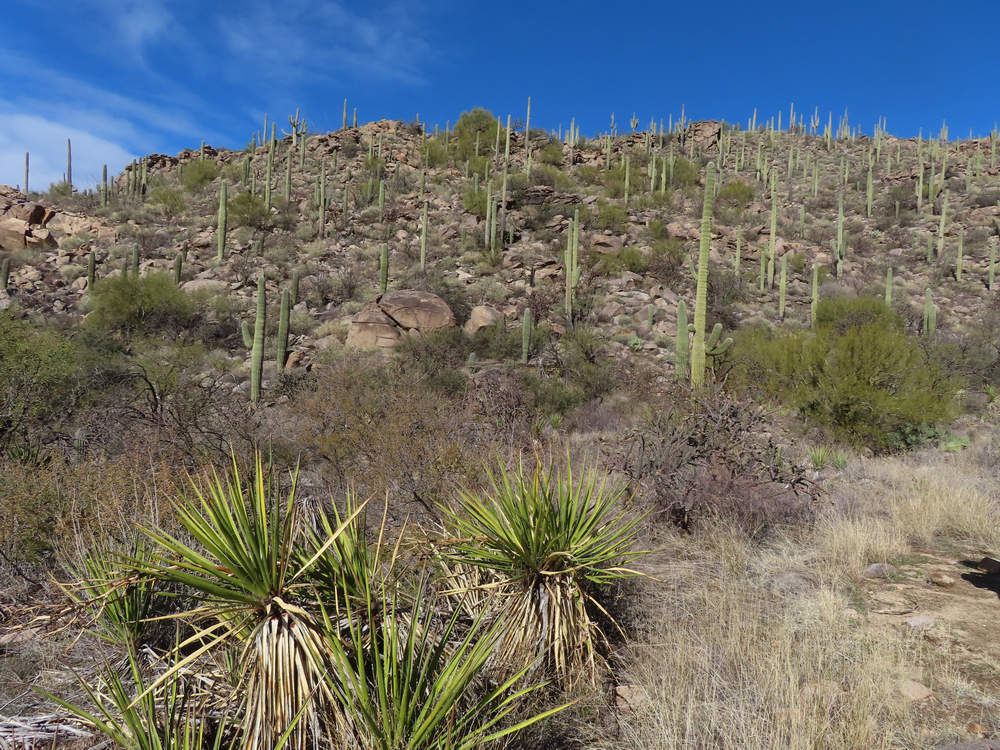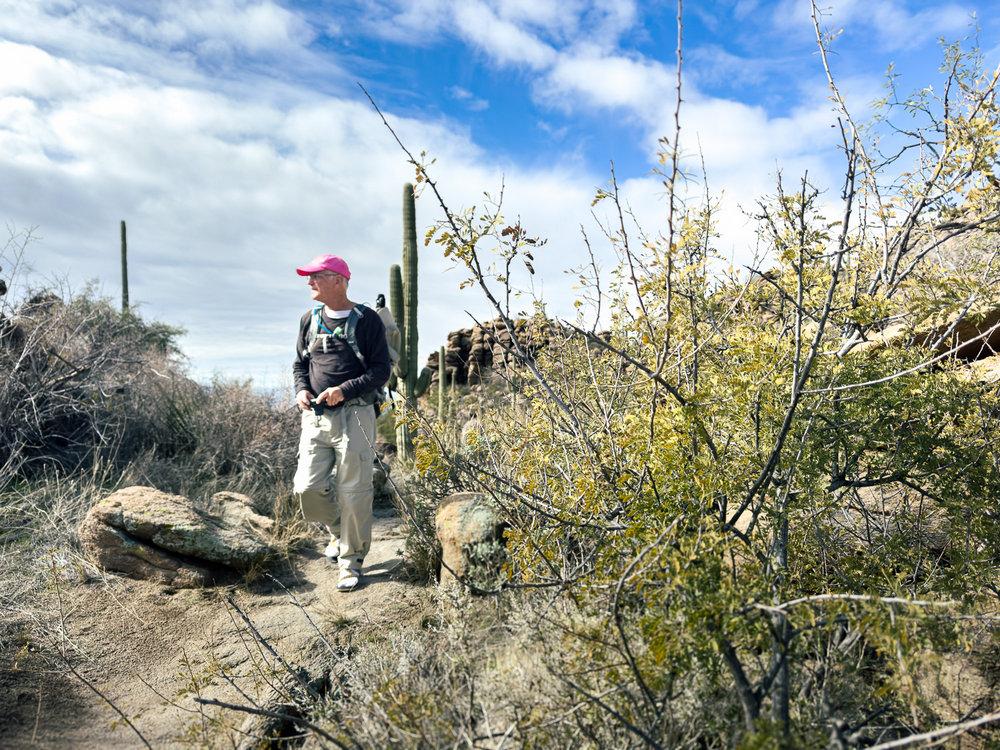Mike Breiding's Epic Road Trips: 2024
Tucson Area Hiking
Tortolita Mountains
Alamo Springs and Wild Mustang Trails Hike
25 January 2024
Tortolita Mountains
Alamo Springs and Wild Mustang Trails Hike
The combination of agreeable winter temperatures and sunshine here in SE Arizona along with 5 mountain ranges with miles and miles of trails can't be beat if you like to hike. We do. And so we do. And so do lots of others.
Betsy took the day off so hiking buddy Bruce and I headed up to the Tortolita Mountains for a day of hiking and gawking at the gorgeous scenery.

Here is an area map for orientation. When we stray outside of the Tucson Mountains to go hiking we are always in for at least 45-60 minutes of driving to the trail heads. Today was no exception.

Here is a route map showing the terrain for today's hike. There was a lot of up and down, some of it quite steep and much of it quite rocky.
The AllTrails route I recorded is here.
Click on the photos below for a larger image.
The Tortolita Mountains are well known for their herds of Javelinas. Javelinas have adapted to feed on prickly pear pads. They clamp down on the pads and strip the soft tissue out leaving behind the stringy fibrous material which holds the pads together.
Mmmm... Tasty! Spines and all.

Source: WikiMedia
Once you see the teeth of a javelina it becomes clear how they can rip a pricky pear pad to shreds.

Photo: themeateater.com
Here is a good look at why the javelina is rightly called a Collared peccary.
There are three species of peccaries in the Southwestern United States through Central America and into South America: White-lipped peccary, Chacoan peccary, and Collared peccary. Of these, only the Collared peccary occurs in Arizona.
Javelinas make all kinds of interesting sounds: teeth clacking, jaw grinding, squealing and woofing. You can listen to a few of those sounds here:
Click the play arrow to a medley of javelina sounds.
Like many wild animals, javelinas have become well urbanized. The above video shows a herd of javelinas feeding on prickly pear in the utility right-of-way behind our trailer (Rancho Relaxo) in Tucson Estates.
Wanna know more?:
Peccary at WikiPedia
Peccary at Arizona Game and Fish
Much of what we hiked through today was fractured and weathered granite. This area is known as "The Great Wall" because of its resemblance to a dry laid stone wall.
Here Bruce follows the trail through this amazing rock jumble. There was much stepping up and stepping down which gave us a good work out.
As with most snap shots these photos do not do this gorgeous landscape justice.
There were many fine saguaro specimens, some of them quite large.
Mixed in with the mesquite were chain fruit, stag horn and teddy bear chollas.
I have heard the reddish/purplish color on the stag horn cholla is a local variant, but I have not been able to verify that. The oblong structures are the seed bearing fruits which clearly show the point where the flowers were attached.
The Torts have the largest stag horn chollas I have seen anywhere with some specimens reaching 12 feet tall with dense branching up to 5 feet across.
We also saw many banana yucca plants, some forming large, dense colonies. The banana yuccas gets its name from the banana shaped fruit born on the woody flower stalks.
Up and down we did go through this fine saguaro forest.
That's Bruce next to a jumbo saguaro. This one could easily be 150 years old or older. There is no precise way to age saguaros so the actual age of any one plant is a mystery.
The previous photos were taken along the Alamo Springs trail. There is an old well at the trail's end that was used by ranchers. The location of that well and old ranch site is here: 32°29'55.4"N 111°03'50.9"W - Google Maps
After lunch we picked up the Wild Mustang trail which would take us through an area with grassland, low scrub and many banana yucca as well as dense stands of saguaro.
The snow and cloud capped mountains in the distance are the Santa Catalinas. This view is of the north side and shows the snow on the highest peak - Mt Lemmon.
This is my monkey-see, monkey-do shot. Bruce took this same view and got a beauty. Mine? Not so much. Note the rounded boulders in the foreground. We are no longer seeing the big fractured and rounded "walls" of granite. We have now moved into an area where most of the rock has been rounded by the process of spherical weathering. But now that I think about it - is it not all from spherical weathering? Can you have a bunch of rocks that are not spherical in shape and still be the result of spherical weathering?
I was hoping a certain geologist friend of mine would answer this question. And he did!
Spherical weathering basically follows the fracture patterns in rocks as chemical weathering attacks exposed edges and surfaces. If the fracture pattern is basically square, then the boulders produced by weathering will be close to spherical. If the fracture patterns in the rocks are more rectangular than square, then the boulders will be elongated but with rounded edges, which is what your photo seems to show. The rocks in question are in deep shadow, but they appear elongated to me.
This is why the word "stunning" was invented. The late afternoon sun produced jaw dropping views with every turn in the trail.
⋄⋄⋄⋄⋄⋄⋄⋄⋄⋄⋄⋄⋄⋄
Here is a sample of Bruce's photos from the hike.
Photo by Bruce Luetters
Photo by Bruce Luetters
Photo by Bruce Luetters
Photo by Bruce Luetters
Photo by Bruce Luetters
Photo by Bruce Luetters
You can seem more of Bruce's tasty photos at 3Sixty Photography
See you next time...
Mike




















